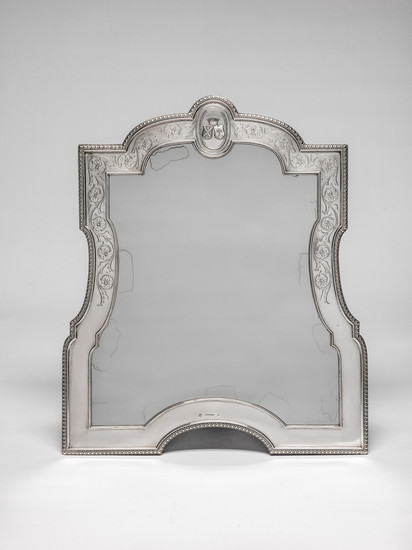Working with the SNG collections offers many opportunities for interdisciplinary collaboration. With the help of my colleague Marek Gilányi, the exhibited silver mirror unveiled to us the history of its origin. Thanks to ongoing research with my colleague Jana Luková, we are discovering more about its original owner and the circumstances of its acquisition into the SNG collections.
Based on markings and hallmarks, it was apparent that the mirror came from the workshop of a renowned Viennese silversmith Josef Carl Klinkosch (1822 – 1888). The company operated from 1869/1870 until 1918 under the brand J. C. Klinkosch, while in 1884, his sons took over the company's leadership. Initially, the mirror was part of a women's toilet set. Arms of alliance aided in more precise dating of the object; these were created by combining the coats of arms belonging to a married couple.
The discovery made by our fellow heraldist was beyond all expectations. The coats of arms belonged to the Saint-Genois and Wachtler families. They were joined only once, during the marriage of Hugo Moritz de Saint-Genois (1858 – 1891) and Eleonore von Wachtler (1863 – 1943) from Pressburg (Bratislava). Considering the intimate nature of the artefact associated with personal hygiene, we can assume that it was the bridegroom's wedding gift for his bride. They were married in March 1889 in Budapest. Eleonore had previously divorced her first husband, and to marry each other, she and Hugo converted to the Protestant (Unitarian) faith. The newlyweds settled in Pressburg. In 1890, Hugo began constructing a villa near the Horský Park within a farm yard called Eleonore's Manor (German: Eleonorenhof, Hungarian: Eleonóra-udvar). Alexander Feigler was most likely its architect and builder. Hugo did not live to see it completed. However, the villa still stands today. You can read about its painting decoration and the fate of the Saint-Genois family in the catalogue for the exhibition prepared in 2019 at the Bratislava City Gallery by the curator Jana Luková.
The mirror came into SNG's collection from the possessions of the antique dealer from Bratislava Eduard Šťastný, which was forfeited to the state in 1962 based on criminal proceedings. Among the more than fifty items, there were mainly small examples of European and Asian artistic crafts. The larger part of his forfeited property is located in the museum at Castle Červený Kameň. We continue our research, and if we are lucky, we might find the missing components of the toilet set right there. Please keep your fingers crossed for us!
The exhibition cycle In the Shop Display enters the public space through the window of Café Berlinka on the ground floor of the Esterházy Palace, presenting works of visual art responding to the issues of contemporary life. In this exhibition format, we have revived collaboration between Peter Bartoš and Július Koller, who in 1968 exhibited their works in a storefront of a stocking repair shop in Klobučnícka Street in Bratislava under the title Interpretation (Anti-gallery).

